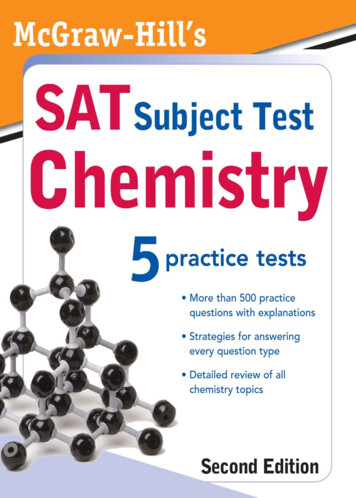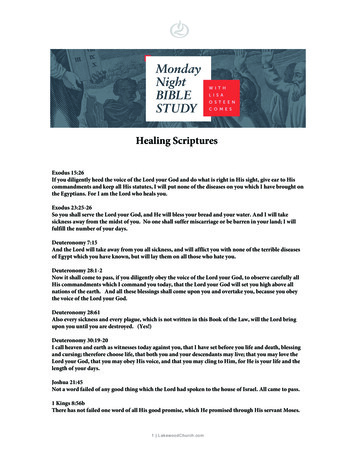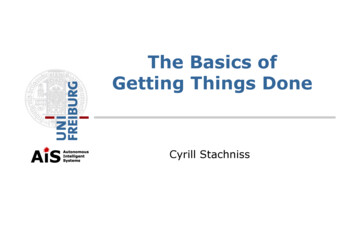
Transcription
THE TOP 40 THINGS YOU NEEDTO KNOW FOR TOP SCORES INCHEMISTRY1. CHANGESUnderstand and be able to identify the difference between physical andchemical changes.See Chapter 1.2. REACTIONSUnderstand and be able to identify the difference between exothermic andendothermic reactions.See Chapter 1.3. MIXTURESKnow the differences between substances, mixtures, and the components ofmixtures.See Chapter 1.4. GAS LAWS AND CALCULATIONSBe able to use the gas laws to calculate moles, pressure, volume, and mass ofa sample of gas at various temperatures and conditions.See Chapter 2.5. MATTERBe able to name the changes in phases of matter and identify them on a heating/cooling curve.See Chapter 2.6. SUBATOMIC PARTICLESUnderstand the properties of the subatomic particles and how they allow isotopes to exist.See Chapter 3.7. ELECTRON CONFIGURATIONBe able to provide the electron configuration of an element given the number of electrons.See Chapter 3.
8. MOLECULESKnow how to distinguish between the various hybridization states and theshapes of molecules that can be formed.See Chapter 3.9. THE OCTET RULEUnderstand the octet rule and how it allows atoms and ions to be stable.See Chapter 3.10. GROUPING AND THE PERIODIC TABLEKnow the properties and names of various groups/families within the periodic table.See Chapter 4.11. METALS, NONMETALS, AND THE PERIODIC TABLEKnow the properties and locations of the metals and nonmetals.See Chapter 4.12. TRENDS AND THE PERIODIC TABLEKnow the trends for electronegativity, ionization energy, and atomic radiusacross the periodic table.See Chapter 4.13. BONDSBe able to distinguish between the various intramolecular bonds: covalent(polar vs. nonpolar), ionic, network covalent, hydrogen, coordinate covalent,metallic, dispersion/Van der Waals, and molecule-ion attraction.See Chapter 5.14. SIGMA AND PI BONDSBe able to tell the difference between sigma and pi bonds and be able tolocate them within a molecule.See Chapter 5.15. COMPOUNDSBe able to name ionic and covalent compounds using both traditional methodsand the stock method.See Chapter 5.
16. CHEMICAL EQUATIONSKnow how to balance and classify chemical equations.See Chapter 6.17. CALCULATIONS OF COMPOUNDSBe able to calculate percent hydration and percent composition of a compound.See Chapter 6.18. SOLUBILITY RULESUnderstand how to use solubility rules to predict the products of a reactionand write net ionic equations.See Chapter 6.19. SOLUTIONSKnow how to calculate the concentration of a solution.See Chapter 6.20. THE MOLEUnderstand how to use the mole to calculate the number of liters a gas willoccupy, the number of molecules present, the mass of a sample, and the number of moles of another substance in a reaction.See Chapter 6.21. POTENTIAL ENERGY DIAGRAMSBe able to draw and label a potential energy diagram.See Chapter 7.22. HEATKnow how to use a potential energy diagram and Hess’s Law to calculate heatinvolved in reactions.See Chapter 7.23. RATE OF REACTIONBe able to determine how to change the rate of reaction.See Chapter 8.24. EQUILIBRIUMBe able to determine how changing conditions changes the point of equilibrium of a reaction.See Chapter 8.
25. PRODUCTS AND REACTANTSUnderstand how to use Keq and Ksp values to find concentrations of productsand reactants.See Chapter 8.26. SPONTANEOUS REACTIONSKnow how to determine if a reaction will be spontaneous.See Chapter 8.27. ACIDS AND BASESUnderstand the various operational and conceptual methods for definingacids and bases.See Chapter 9.28. KaUnderstand what Ka can tell us about an acid or a base.See Chapter 9.29. MOLARITY AND pHKnow how to calculate the molarity and pH of an acid or a base solution.See Chapter 9.30. OXIDATION NUMBERSBe able to determine the oxidation numbers for the elements in a compound.See Chapter 10.31. OXIDIZING AND REDUCING AGENTSKnow how to identify the substances that had a change in oxidation number and identify which serve as an oxidizing or a reducing agent in a halfreaction.See Chapter 10.32. REDOX REACTIONSBe able to balance both simple and complex redox reactions.See Chapter 10.33. VOLTAIC AND ELECTROLYTIC CELLSKnow how to determine the reactions that occur within voltaic and electrolyticcells.See Chapter 10.
34. PREFIXESUnderstand the prefixes used in organic chemistry so as to know the numberof carbon atoms present in a molecule.See Chapter 11.35. FUNCTIONAL GROUPS IN ORGANIC CHEMISTRYBe able to distinguish between the various functional groups in organicchemistry which contain oxygen, nitrogen, and double and triple bonds.See Chapter 11.36. RADIATIONBe able to identify the risks and benefits of using radiation.See Chapter 12.37. NUCLEAR EMANATIONSKnow the differences between various types of nuclear emanations.See Chapter 12.38. HALF-LIFE AND MASS CALCULATIONSBe able to calculate the half-life of an isotope or the mass of a radioactivesample after a certain period of time.See Chapter 12.39. LABORATORY TECHNIQUESUnderstand safe and general laboratory techniques.See Chapter 13.40. LABORATORY CALCULATIONSKnow how to make all necessary calculations pertaining to experiments carried out in the laboratory.See Chapter 13.
This page intentionally left blank
McGRAW-HILL’sSATSUBJECT TESTCHEMISTRY
This page intentionally left blank
McGRAW-HILL’sSATSUBJECT TESTCHEMISTRYSecond EditionThomas A. EvangelistAssistant Principal, Supervision of ScienceNew York City Department of EducationNew York / Chicago / San Francisco / Lisbon / London / Madrid / Mexico CityMilan / New Delhi / San Juan / Seoul / Singapore / Sydney / Toronto
Copyright 2009 by The McGraw-Hill Companies, Inc. All rights reserved. Except as permitted under the United States Copyright Act of 1976, no partof this publication may be reproduced or distributed in any form or by any means, or stored in a database or retrieval system, without the prior writtenpermission of the publisher.ISBN: 978-0-07-160885-5MHID: 0-07-160885-0The material in this eBook also appears in the print version of this title: ISBN: 978-0-07-160884-8, MHID: 0-07-160884-2.All trademarks are trademarks of their respective owners. Rather than put a trademark symbol after every occurrence of a trademarked name, we usenames in an editorial fashion only, and to the benefit of the trademark owner, with no intention of infringement of the trademark. Where suchdesignations appear in this book, they have been printed with initial caps.McGraw-Hill eBooks are available at special quantity discounts to use as premiums and sales promotions, or for use in corporate training programs. Tocontact a representative please e-mail us at bulksales@mcgraw-hill.com.This publication is designed to provide accurate and authoritative information in regard to the subject matter covered. It is sold with the understandingthat neither the author nor the publisher is engaged in rendering legal, accounting, futures/securities trading, or other professional service. If legal adviceor other expert assistance is required, the services of a competent professional person should be sought.—From a Declaration of Principles jointly adopted by a Committee of the American Bar Association and a Committee of PublishersSAT is a registered trademark of the College Entrance Examination Board, which was not involved in the production of, and does not endorse, thisproduct.TERMS OF USEThis is a copyrighted work and The McGraw-Hill Companies, Inc. (“McGraw-Hill”) and its licensors reserve all rights in and to the work. Use of thiswork is subject to these terms. Except as permitted under the Copyright Act of 1976 and the right to store and retrieve one copy of the work, you may notdecompile, disassemble, reverse engineer, reproduce, modify, create derivative works based upon, transmit, distribute, disseminate, sell, publish or sublicense the work or any part of it without McGraw-Hill’s prior consent. You may use the work for your own noncommercial and personal use; any otheruse of the work is strictly prohibited. Your right to use the work may be terminated if you fail to comply with these terms.THE WORK IS PROVIDED “AS IS.” McGRAW-HILL AND ITS LICENSORS MAKE NO GUARANTEES OR WARRANTIES AS TO THE ACCURACY, ADEQUACY OR COMPLETENESS OF OR RESULTS TO BE OBTAINED FROM USING THE WORK, INCLUDING ANYINFORMATION THAT CAN BE ACCESSED THROUGH THE WORK VIA HYPERLINK OR OTHERWISE, AND EXPRESSLY DISCLAIM ANYWARRANTY, EXPRESS OR IMPLIED, INCLUDING BUT NOT LIMITED TO IMPLIED WARRANTIES OF MERCHANTABILITY OR FITNESSFOR A PARTICULAR PURPOSE. McGraw-Hill and its licensors do not warrant or guarantee that the functions contained in the work will meet yourrequirements or that its operation will be uninterrupted or error free. Neither McGraw-Hill nor its licensors shall be liable to you or anyone else for anyinaccuracy, error or omission, regardless of cause, in the work or for any damages resulting therefrom. McGraw-Hill has no responsibility for the contentof any information accessed through the work. Under no circumstances shall McGraw-Hill and/or its licensors be liable for any indirect, incidental,special, punitive, consequential or similar damages that result from the use of or inability to use the work, even if any of them has been advised of thepossibility of such damages. This limitation of liability shall apply to any claim or cause whatsoever whether such claim or cause arises in contract, tortor otherwise.
Dedicated to:My loving and supportive family,My students who are worth all the effort,My friends who have been there over the years,My colleagues who have been behind me 100 percent,My teammates who put it all on the line game after game,Everyone who has taught me something over the past 30-plus years.Let’s never stop learning. . . .
This page intentionally left blank
CONTENTSPART I. INTRODUCTION TO THE SAT CHEMISTRY TEST1All About the SAT Chemistry Test / 3How to Use This Book / 9Strategies for Top Scores / 10PART II. DIAGNOSTIC TEST15Diagnostic Test / 17Answers and Explanations to Diagnostic Test / 29PART III. CHEMISTRY TOPIC 4567891011121339Matter and Energy / 41Phases of Matter / 47Atomic Structure / 60The Periodic Table and Periodic Trends / 76Bonding / 84Stoichiometry and Solution Chemistry / 101Energy and Chemical Reactions / 118Reaction Rates and Chemical Equilibrium / 127Acids and Bases / 139Redox and Electrochemistry / 151Organic Chemistry / 167Nuclear Chemistry / 176Laboratory Skills / 185PART IV. FOUR FULL-LENGTH PRACTICE TESTS195Practice Test 1 / 197Answers and Explanations / 210Practice Test 2 / 219Answers and Explanations / 230Practice Test 3 / 239Answers and Explanations / 251Practice Test 4 / 261Answers and Explanations / 274APPENDIXES283Appendix 1Appendix 2Appendix 3Mathematical Skills Review / 285Equations and Symbols / 289Periodic Table of the Elements / 291Appendix 4Appendix 5Reference Tables / 293Glossary / 295xiii
This page intentionally left blank
McGRAW-HILL’sSATSUBJECT TESTCHEMISTRY
This page intentionally left blank
PART IINTRODUCTIONTO THE SATCHEMISTRYTEST
This page intentionally left blank
All About the SAT Chemistry TestTHE SAT SUBJECT TESTSWhat Are the SAT Subject Tests?The SAT Subject Tests (formerly called the SAT II tests and the AchievementTests) are a series of college entrance tests that cover specific academic subjectareas. Like the better-known SAT test, which measures general verbal andmath skills, the SAT Subject Tests are given by the College Entrance Examination Board. Colleges and universities often require applicants to take oneor more SAT Subject Tests along with the SAT.SAT Subject Tests are generally not as difficult as Advanced Placementtests, but they may cover more than is taught in basic high school courses.Students usually take an SAT Subject Test after completing an AdvancedPlacement course or an Honors course in the subject area.How Do I Know if I Need to Take SAT Subject Tests?Review the admissions requirements of the colleges to which you plan toapply. Each college will have its own requirements. Many colleges requirethat you take a minimum number of SAT Subject Tests—usually one or two.Some require that you take tests in specific subjects. Some may not requireSAT Subject Tests at all.When Are SAT Subject Tests Given, and How Do I Register for Them?SAT Subject Tests are usually given on six weekend dates spread throughout the academic year. These dates are usually the same ones on which theSAT is given. To find out the test dates, visit the College Board Web site atwww.collegeboard.com. You can also register for a test at the Web site. Clickon the tabs marked “students” and follow the directions you are given. Youwill need to use a credit card if you register online. As an alternative, you canregister for SAT Subject Tests by mail using the registration form in the SATRegistration Bulletin, which should be available from your high school guidance counselor.How Many SAT Subject Tests Should I Take?You can take as many SAT Subject Tests as you wish. According to the College Board, more than one-half of all SAT Subject Test takers take three tests,and about one-quarter take four or more tests. Keep in mind, though, that youcan take only three tests on a single day. If you want to take more than threetests, you’ll need to take the others on a different testing date. When decidinghow many SAT Subject Tests to take, base your decision on the requirementsof the colleges to which you plan to apply. It is probably not a good idea totake many more SAT Subject Tests than you need. You will probably dobetter by focusing only on the ones that your preferred colleges require.3
4PART I / INTRODUCTION TO THE SAT CHEMISTRY TESTWhich SAT Subject Tests Should I Take?If a college to which you are applying requires one or more specific SATSubject Tests, then of course you must take those particular tests. If the college simply requires that you take a minimum number of SAT Subject Tests,then choose the test or tests for which you think you are best prepared andlikely to get the best score. If you have taken an Advanced Placement courseor an Honors course in a particular subject and done well in that course, thenyou should probably consider taking an SAT Subject Test in that subject.When Should I Take SAT Subject Tests?Timing is important. It is a good idea to take an SAT Subject Test as soon aspossible after completing a course in the test subject, while the course material is still fresh in your mind. If you plan to take an SAT Subject Test in asubject that you have not studied recently, make sure to leave yourselfenough time to review the course material before taking the test.What Do I Need on the Day of the Test?To take an SAT Subject Test, you will need an admission ticket to enter theexam room and acceptable forms of photo identification. You will alsoneed two number 2 pencils. Be sure that the erasers work well at erasingwithout leaving smudge marks. The tests are scored by machine, and scoring can be inaccurate if there are smudges or other stray marks on the answer sheet.Any devices that can make noise, such as cell phones or wristwatchalarms, should be turned off during the test. Study aids such as dictionariesand review books, as well as food and beverages, are barred from the testroom.THE SAT CHEMISTRY TESTWhat Is the Format of the SAT Chemistry Test?The SAT Chemistry test is a one-hour exam consisting of 85 multiple-choicequestions. According to the College Board, the test measures the followingknowledge and skills: Familiarity with major chemistry concepts and ability to use those concepts to solve problems Ability to understand and interpret data from observation and experiments and to draw conclusions based on experiment results Knowledge of laboratory procedures and of metric units of measure Ability to use simple algebra to solve word problems Ability to solve problems involving ratio and direct and inverse proportions, exponents, and scientific notationThe test covers a variety of chemistry topics. The following chart shows thegeneral test subject areas, as well as the approximate portion of the test devoted to each subject.
ALL ABOUT THE SAT CHEMISTRY TEST5SAT Chemistry Subject AreasSubject AreaApproximate Percentage of Exam1. Structure of Matter25%2. States of Matter15%3. Reaction Types14%4. Stoichiometry12%5. Equilibrium and Reaction Rates7%6. Thermodynamics6%7. Descriptive Chemistry8. Laboratory13%8%When you take the SAT Chemistry test, you will be given a test bookletthat includes a periodic table of the elements. The table will show only theelement symbols, atomic numbers, and atomic masses. It will not show electron configurations or oxidation numbers. You may not use your own reference tables or a calculator.What School Background Do I Need for the SAT Chemistry Test?The College Board recommends that you have at least the following experience before taking the SAT Chemistry test: One-year chemistry course at the college preparatory level One-year algebra course Experience in the chemistry laboratoryHow Is the SAT Chemistry Test Scored?On the SAT Chemistry test, your “raw score” is calculated as follows: Youreceive one point for each question you answer correctly, but you lose onequarter point for each question you answer incorrectly. You do not gain orlose any points for questions that you do not answer at all. Your raw score isthen converted into a scaled score by a statistical method that takes intoaccount how well you did compared to others who took the same test. Scaledscores range from 200 to 800 points. Your scaled score will be reported toyou, to your high school, and to the colleges and universities that you designate to receive it.Scoring scales differ slightly from one version of the test to the next. Thescoring scales provided after each practice test in this book are only samplesthat will show you your approximate scaled score.
6PART I / INTRODUCTION TO THE SAT CHEMISTRY TESTWhen Will I Receive My Score?Scores are mailed to students approximately three to four weeks after thetest. If you want to find out your score a week or so earlier, you can do so forfree by accessing the College Board Web site or for an additional fee by calling (866)756-7346.How Do I Submit My Score to Colleges and Universities?When you register to take the SAT or SAT Subject Tests, your fee includesfree reporting of your scores to up to four colleges and universities. To haveyour scores reported to additional schools, visit the College Board Web siteor call (866)756-7346. You will need to pay an additional fee.SAT CHEMISTRY QUESTION TYPESThe SAT Chemistry test consists entirely of multiple-choice questions. Mostare the regular five-answer-choice format that you will be familiar withfrom taking other standardized tests. Some, however, have special formatsthat do not appear on other tests and that you need to be aware of. TheCollege Board calls these formats “classification sets” and “relationshipanalysis questions.” Review the following examples before you tackle theDiagnostic Test.Regular Multiple-Choice QuestionsOn the SAT Chemistry test, most of the questions are in the regular fiveanswer-choice format that is used on standardized tests such as the SAT.Here is an example:1. Which oxidation half reaction below demonstrates conservation of massand charge?(A)Mg2 2e– Mg(B)Cl1 1e– Cl2(C)2Ag1 2Ag 1e–(D)Mg Mg2 2e–(E)F2 2e– 2F1 The correct answer is choice D. Note that with this question, as with manyother questions on the test, you can find the correct answer by using theprocess of elimination. The half reactions shown in choices A, B, and E areall reduction half reactions, so those choices can be eliminated. Both remaining choices, C and D, show oxidation and a loss of electrons. Butchoice C does not demonstrate conservation of charge and mass; if it did,there would have to be two electrons on the left side of the reaction. So thecorrect answer must be choice D.You will see a variation of this basic format in which you are offered threechoices indicated by the Roman numerals I, II, and III. Your task is to decide which combination of the three choices answers the question. Here isan example:
ALL ABOUT THE SAT CHEMISTRY TEST72. Which of the following indicates an acidic solution?I.Litmus paper turns blue.II.Phenolphthalein turns pink.III. Hydronium ion concentration is greater than hydroxide ion concentration.(A) I only(B) II only(C) III only(D) I and II only(E) I, II, and IIIThe correct answer is choice C. First, review the choices. Choices I and II indicate a basic solution. If they were acidic, then the solutions would be redfor litmus and clear for phenolphthalein. Only choice III holds true for anacidic solution. In an acidic solution the concentration of hydronium ions exceeds that of hydroxide ion concentration.Classification SetsIn a classification set, you are given five answer choices lettered A through E.The choices may be chemistry principles, substances, numbers, equations,diagrams, or the like. The choices are followed by three or four numberedquestions. Your task is to match each question with the answer choice towhich it refers. Here are sample directions for a classification set, followedby a sample of this question format.Directions: Each of the following sets of lettered choices refers to the numbered formulas orstatements immediately below it. For each numbered item, choose the one lettered choice thatfits it best. Then fill in the corresponding oval on the answer sheet. Each choice in a set may beused once, more than once, or not at all.Questions 3–5:(A)(B)(C)(D)(E)Coordinate covalent bondingIonic bondingNonpolar covalent bondingMetallic bondingHydrogen bonding3. HF4. N25. KI3. The correct answer is choice E. The bond between the atoms of hydrogen and fluorine is a polar covalent bond, a choice that is not present inthe choices above. Now look at the bonding between the molecules of HF.HF can exhibit dipole forces between its molecules, yet another choice thatis not present. HF can, however, exhibit hydrogen bonding, a choice thatis present.
8PART I / INTRODUCTION TO THE SAT CHEMISTRY TEST4. The correct answer is choice C. Nitrogen gas has no difference in electronegativity between the nitrogen atoms. The two nitrogen atoms will form anonpolar covalent bond. The type of bonding present between the moleculesof nitrogen gas will be dispersion forces, the forces present between nonpolarmolecules.5. The correct answer is choice B. Potassium iodide is formed from a metal,potassium, and a nonmetal, iodine. The type of bonding that forms betweenmetals and nonmetals is ionic bonding.Relationship Analysis QuestionsRelationship analysis questions are probably not like any question type thatyou have seen before. Each question consists of two statements labeled I andII with the word BECAUSE between the two statements. For each question,you have three tasks. You must: Determine if statement I is true or false. Determine if statement II is true or false. Determine if statement II is the correct explanation for statement I.On the answer sheet, you will mark true (T) or false (F) for each statement, andyou will mark “correct explanation” (CE) ONLY if statement II is a correct explanation of statement I. Here are sample directions for this kind of question,followed by two examples and a sample of a correctly marked answer sheet.Directions: Each question below consists of two statements. For each question, determinewhether statement I in the leftmost column is true or false and whether statement II in the rightmost column is true or false. Fill in the corresponding T or F ovals on the answer sheet provided. Fill in the oval labeled “CE” only if statement II correctly explains statement I.101 HCl is an Arrhenius acidBECAUSEHCl is a proton donor.102 Water is a polar moleculeBECAUSEthe dipole forces in a molecule ofwater will counterbalance each otherand cancel out.101.T, T, CE HCl will donate a proton (hydronium ion) when it reacts.This classifies it as an Arrhenius acid.102.T, FBecause of the bent shape of a water molecule, the dipoleforces in the molecule will not counterbalance or cancelout. This is what causes a water molecule to be a polarmolecule.Here is how you would mark these answers on the answer sheet:I101102IIFFFCE*T
HOW TO USE THIS BOOK9How to Use This BookThe SAT Chemistry test covers a very large amount of material, and yourpreparation time may be short. That is why it is important to use your studytime wisely. This book provides a comprehensive review of everything youneed to know for the test, and it has been organized to make your study program practical and efficient. It will help you: Identify the chemistry topics that you most need to focus on.Familiarize yourself with the test format and test question types.Review all the basic chemistry you need to know for the test.Check your progress with questions at the end of each review chapter.Practice your test-taking skills using sample tests.The following four-step study program has been designed to help youmake the best use of this book.STEP 1TAKE THE DIAGNOSTIC TESTOnce you have read through this chapter, start your preparation programby taking the Diagnostic Test. This test is carefully modeled on the real SATChemistry test in terms of format, types of questions, and topics tested.Take the Diagnostic Test under test conditions and pay careful attention tothe one-hour time limit. When you complete the test, score yourself usingthe scoring information at the end of the test. Then read through the explanations to see which test topics gave you the most trouble. Look for patterns. Did you miss questions in one or two specific subject areas? Didspecific question formats give you trouble? When did you need to guess atthe answer? Use your results to identify the topics and question types thatwere most difficult for you. Once you know your chemistry strengths andweaknesses, you’ll know which subjects you need to focus on as you reviewfor the test.STEP 2REVIEW THE TEST TOPICSThis book provides a full-scale review of all the topics tested on the SATChemistry test. Once you have identified the topics that give you the mosttrouble, review the relevant chapters. You do not need to work through thereview chapters in the order in which they appear. Skip around if you like,but remember to focus on the topics that gave you the most trouble on theDiagnostic Test.Each review chapter ends with practice problems that you can use to seehow well you have mastered the material. If you get a problem wrong, goback into the chapter and reread the section that covers that particulartopic.Make a study schedule. If you have the time, plan to spend at least twoweeks or so working your way through the review chapters. Be sure to setaside enough time at the end of your schedule to take the practice tests at theend of the book. However, if you do not have much time before the test, youmay want to shorten your review time and focus instead entirely on the practice tests.
10PART I / INTRODUCTION TO THE SAT CHEMISTRY TESTSTEP 3BUILD YOUR TEST-TAKING SKILLSAs you work through the examples and review questions in each review chapter, you’ll become familiar with the kinds of questions that appear on the SATChemistry test. You’ll also practice the test-taking skills essential for topscores. These include: The ability to recall and comprehend major concepts in chemistry and toapply them to solve problems The ability to interpret information gained from observations and experiments The ability to make inferences from experimental data, including datapresented in graphs and tablesSTEP 4TAKE THE PRACTICE TESTSOnce you have completed your review of all the SAT Chemistry topics, getready for the real exam by taking the four practice tests at the back of thisbook. When you take each test, try to simulate actual test conditions. Sit in aquiet room, time yourself, and work through as much of the test as timeallows. The tests are ideal for practice because they have been constructed tobe as much like the real test as possible. The directions and practice questions are very much like those on the real test. You’ll gain experience with thetest format, and you’ll learn to pace yourself so that you can earn the maximum number of points in the time allowed.Each test will also serve as a review of the topics tested because completeexplanations are provided for every question. The explanations can be foundat the end of each test. If you get a question wrong, you’ll want to review theexplanation carefully. You may also want to go back to the chapter in thisbook that covers the question topic.Each review chapter ends with practice problems that you can use to seehow well you have mastered the material. If you get a problem wrong, goback into the chapter and reread the section that covers that particulartopic.At the end of each test you’ll also find scoring information. Calculate yourraw score, then use the table provided to find your approximate scaled score.The scaling on the real test may be slightly different, but you’ll get a good ideaof how you might score on the actual test.Strategies for Top ScoresWhen you take the SAT Chemistry test, you’ll want to do everything you canto make sure you get your best possible score. That means studying right,building good problem-solving skills, and learning proven test-taking strategies. Here are some tips to help you do your best.STUDY STRATEGIES Get to know the format of the exam. Use the practice tests in this bookto familiarize yourself with the test format, which does not change fromyear to year. That way, you’ll know exactly what to expect when you seethe real thing on test day.
STRATEGIES FOR TOP SCORES11 Get to know the test directions. If you are familiar with th
PART I. INTRODUCTION TO THE SAT CHEMISTRY TEST 1 All About the SAT Chemistry Test / 3 How to Use This Book / 9 Strategies for Top Scores / 10 PART II. DIAGNOSTIC TEST 15 . FOUR FULL-LENGTH PRACTICE TESTS 195 Practice Test 1 / 197 Answers and Explanations / 210 Practice Test 2 / 219 Answers and Explanations / 230 Practice Test 3 / 239











